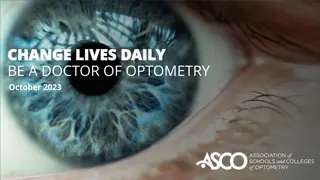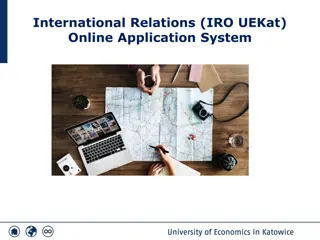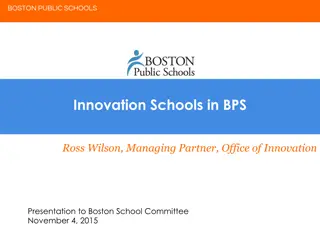Guide to Optometry Schools and Application Process
Explore the world of optometry with a detailed guide on the application process, available schools in Ontario, Quebec, and the USA, and the responsibilities of optometrists. Learn about the Doctor of Optometry degree, where you can study optometry, and a comprehensive list of schools in the USA offering optometry programs. Get insights into what optometrists do, from prescribing glasses to diagnosing ocular diseases. Whether you're considering a career in optometry or want to learn more about this field, this guide has all the information you need.
Download Presentation

Please find below an Image/Link to download the presentation.
The content on the website is provided AS IS for your information and personal use only. It may not be sold, licensed, or shared on other websites without obtaining consent from the author.If you encounter any issues during the download, it is possible that the publisher has removed the file from their server.
You are allowed to download the files provided on this website for personal or commercial use, subject to the condition that they are used lawfully. All files are the property of their respective owners.
The content on the website is provided AS IS for your information and personal use only. It may not be sold, licensed, or shared on other websites without obtaining consent from the author.
E N D
Presentation Transcript
HOW TO GET INTO OPTOMETRY SCHOOL (SOS) 1 *Presentation will be available online: http://bethune.yorku.ca/events/
INTRODUCTION 1. Who are we? Eraad Rahman: B.Sc. Psychology graduate Miranda Ramnaraine: 4thyear Chemistry student 2
AGENDA About Optometry Available Schools Application Process After Graduation 3
ABOUT OPTOMETRY A Doctor of Optometry (OD) Primary health care provider Provincially licensed, independent Specializes in the examination, diagnosis, treatment, management and prevention of diseases and disorders of the human visual system, the eye, and the associated structures 4
WHAT THEY DO... 1. Prescribe glasses and contact lenses 2. Rehabilitate the visually impaired 3. Diagnose and treat ocular diseases 4. Perform comprehensive examinations of both the internal and external structures of the eye 5
WHAT THEY DO 5. Evaluate patients vision and determine appropriate treatments 6. Treat clarity problems or eye diseases such as glaucoma and ulcers 7. Diagnose complications due to the aging process, accidents, or 6 malfunction
WHERE CAN I STUDY OPTOMETRY? In Ontario University of Waterloo - School of Optometry In Quebec Universit de Montr al L cole d optom trie In the U.S. 23 Schools in the USA 7
LIST OF SCHOOLS IN THE U.S. 1. Ferris State College Michigan College of Optometry 11. Pacific University Forest Grove, OR 12. Southern California College of Optometry 2. Illinois College 3. Indiana University 13. Southern College Memphis, TN 4. InterAmerican University of Puerto Rico 14. State University of New York College of Optometry 5. Midwestern University, Arizona College of Optometry, Glendale, AZ 15. University of Alabama at Birmingham 6. New England College of Optometry 16. University of California Berkeley Optometry 7. Northeastern State University College of Optometry Tahlequah, OK 17. University of Houston Optometry 8. NOVA Southeastern University, Ft. Lauderdale-- Davie, FL 18. University of the Incarnate Word Rosenberg School of Optomtery, San Antonio, TX 8 9. Ohio State University 19. University of Missouri- St. Louis 10. Pennsylvania College of Optometry at Salus University 20. Western University of Health Sciences, Pomona, CA
We will only be focusing on the University of Waterloo School of Optometry in this seminar 9
OPTOMETRY AT WATERLOO Four year program First year class size: 90 students However ~300 applicants/year **They have no preference for undergraduate universities 10
OPTOMETRY AT WATERLOO First & Second Years: Visual optics, visual neurophysiology, cell and molecular biology, pharmacology, genetics, epidemiology, and ethics Third Year: Clinical internship, Fourth Year: Consists of 3 clinical terms one will be on campus, other 2 will be outside 11
WATERLOO SCHOOL OF OPTOMETRY TIMELINE For September 2020 Admissions - Applications available: mid July, 2019 Deadline to write OAT (Optometry Admission Test): August 31st, 2019 Online application and payment deadline: October 1st 2019 Deadline for Admission Information Form (AIF) and 12 interim transcripts: October 26th, 2019
WATERLOO SCHOOL OF OPTOMETRY TIMELINE Deadline for both confidential assessment forms = November 30th, 2019 **Interview selection will have finished by December 1st 2019** Interviews will be held the week of January 11th, 2020 Deadline for final fall 2019 transcripts = January 31st, 2020 Admission Decision letters mailed: End of March 2020 All winter courses must be completed by May 7th 2020 Deadline for final winter 2020 transcripts: June 25th, 2020 13
ADMISSION REQUIREMENTS Academic: 3 or more years BSc With a full course load Overall GPA Maintain a minimum overall average of 75% Recent acceptance averages ranged 79%-92% 14
PROFILE 15
PREREQUISITE COURSES 1 term = 3 credit-courses 2 terms = 6 credit-courses York equivalent PHIL 2070 PHIL 2075 PHIL 2070 OR PHIL 2075 16 PSYCH 1010
PREREQUISITE COURSES York equivalent BIOL 1000 & 1001 BIOL 3150 BIOL 3060 & 3070 OR KINE 2011 & 3012 17
PREREQUISITE COURSES York equivalent CHEM 1000 OR 1001 BIOL 2020 CHEM 2020 OR 202118
York equivalent MATH 1013 OR MATH 1300 (not 1505) MATH 1131 OR BIOL 2060 OR PSYCH 2020 OR KINE 2050 19
PREREQUISITE COURSES York equivalent PHYS 1010 OR 1410 OR 1420 20
COURSE ELIGIBILITY If you are still uncertain, first contact an undergraduate advisor at York. Subsequently, help can be obtained by sending an e mail to opt-admissions@uwaterloo.ca 21
COURSE ELIGIBILITY Your full name Your e-mail address The prerequisite in question The university name The name of the BSc program The course name & number A full course description A web reference to the course description (usually found in the undergraduate calendar) 22
ADMISSION REQUIREMENTS (NON ACADEMIC) Optometry Admissions Test (OAT) more details at http://www.opted.org/ Minimum score= 300 Avg for 2019 applicants = 370 Confidential Assessment Forms An optometrist CAF; expected that you spend a minimum of 8 hours of job shadowing with an optometrist A character CAF. (For example, the character CAF can be from an employer, supervisor, professor, minister.) It should be from someone who knows you well. https://uwaterloo.ca/optometry-vision-science/future-optometry-students/ admission- requirements/non-academic-requirements 23
ADMISSION REQUIREMENTS (NON ACADEMIC) Canadian Citizenship - Or living in Canada for the last 12 months prior to first day of registration (September 2020) - English Language Requirements Test of English as a Foreign Language (TOEFL): - Paper- based: 580 or Computer- based: 237 and Essay Rating: 4.5 and Test of Spoken English: 45 The International English Language Testing System (IELTS): 7.0 The Michigan English Language Assessment Battery (MELAB): 85 24
ADMISSION REQUIREMENTS (NON ACADEMIC) Non-Academic Autobiographical sketch: Academic awards Non-academic awards Work experience Volunteer experience Job shadowing or working with an optometrist 25
ADMISSION REQUIREMENTS Police check (Criminal Record Check) **New admission requirement for September 2017** The CASPer Test: Computer-Based Assessment for Sampling Personal Characteristics You will need access to a computer with audio capabilities, a webcam and reliable internet connection on your selected test date Consists of 12 sections of video and written scenarios Answer a set of questions under a time limit 26 Go to takeCASPer.com for an example of the test structure and more information!
PRACTICE CASPER QUESTION: https://takecasper.com/sample-casper-content/ 27
APPLICATION PROCESS OUAC (Ontario University Application Center) Application Program choice: September 2020 entry in Optometry Personal information (Basic ID, citizenship, etc.) Postal code and email address Post-secondary Academic Background Transcripts 28 Fee: $215
APPLICATION PROCESS After submitting online: Confirmation email Within two weeks PDF file: Optometry Instructions Includes instructions for filling out the Admission Information Form (AIF) 29
STEPS TO GET READY FOR THE OAT 1) Read the OAT guide Eligibility requirements - 2) Apply to Take the Test non- refundable fee of $330 - 3) Schedule the test appointment at a Prometric Test centre https://www.prometric.com/en- us/Pages/home.aspx More info: https://www.ada.org/oat/ 30
OAT 31 https://www.ada.org/oat/oat_examinee_guide.pdf
OA T NATURAL SCIENCES Covers Biology (40 questions) General chemistry (30 questions) Organic chemistry (30 questions) You have 90 minutes to complete 100 questions. 32
OAT SAMPLE QUESTIONS Which of the following are typically autotrophic? A. Protozoa B. Plants C. Animals D. E. Fungi Bacteria Which one of the following processes is accompanied by a decrease in entropy? A. Freezing of water B. Evaporation of water C. D. E. Sublimation of carbon dioxide Shuffling a deck of cards Heating a balloon filled with a gas 33
OA T COMPREHENSION Questions, based on three reading passages (between 1,200 and 1,500 words each) related to basic or clinical science. You do not need prior scientific knowledge to complete this section. READING Includes 40 questions to be completed in 50 minutes. 34
OA T PHYSICS TEST Measures your knowledge of: Vectors Energy and momentum Waves Thermodynamics Magnetism Optics Includes 40 questions covered in 50 minutes. 35
OAT SAMPLE QUESTIONS Sample Questions A vector quantity is BEST described as having A. A direction only B. A magnitude only C. Units only A magnitude and a direction D. Significant figures E. 36
OAT SAMPLE QUESTIONS A magnifying glass is constructed when the lens is A. Converging and the object is located at twice the focal length B. Converging and the object is between the lens and the focal point C. Diverging and the object is at twice the focal length D. Diverging and the object is between the lens 37
OA T QUANTITATIVE REASONING This section measures Mastery of arithmetic Algebra Geometry Trigonometry Consists of 40 questions answered in 45 minutes. 38
OAT SAMPLE QUESTIONS A tank can be filled by a pipe in 30 minutes and emptied by another pipe in 50 minutes. How many minutes will it take to fill the tank if both pipes are open? A. 45 B. 60 C. 75 D. 39 80
OA T Lasts about 25 minutes AN UNSCORED SECTION Can include science, math, or physics questions. They are experimental questions to see if the questions are appropriate before they are included among the scored items Will not affect your score report 40
OA T The OAT is scored on a scale from 200 to 400 Separate sub scores for the different sections: biology, general chemistry, organic chemistry, reading comprehension, and quantitative reasoning. 41
OAT WATERLOO REQUIREMENTS Minimum score of 300, no total section score below 300 Average OAT score for 2019 Waterloo Optometry applicants: 370 42
INTERVIEW If you pass the first cut, you will get an interview Interviews will be contacted at the School in late November The interviews will be conducted at the School in January, 2020 and will consist of: Multi Mini interviews with faculty and members of the profession A round table discussion with our current OD students 43 Tour of the facility
APPLYING TO SCHOOLS OTHER THAN WATERLOO Apply online on school- by- school basis. Usually an Application for Admission to the School of Optometry form will be emailed to you from each school Each school may have its own requirements, common ones are: Referral letters Autobiographical sketch Official university transcripts, OAT scores to be sent to each Optometry school by deadline (arranged by you) Interview 44
POST GRADUATION Write and pass the professional board & jurisprudence exams for the geographic regions you wish to practice Find a place to practice, be a resident, or enter grad studies 45
INTERESTING FACTS The average Canadian optometrist in practice earns$_______________ per year, excluding benefits How long does an optometrist stay in the career? _______________________________ There are approximately _____ practicing optometrists in Canada 46
INTERESTING FACTS The average Canadian optometrist in practice earns$80,000 $100,000 per year, excluding benefits How long does an optometrist stay in the career? _______________________________ There are approximately _____ practicing optometrists in Canada 47
INTERESTING FACTS The average Canadian optometrist in practice earns$80,000 $100,000 per year, excluding benefits How long does an optometrist stay in the career? Typically life- long, until retirement There are approximately _____ practicing optometrists in Canada 48
INTERESTING FACTS The average Canadian optometrist in practice earns$80,000 $100,000 per year, excluding benefits How long does an optometrist stay in the career? Typically life- long, until retirement There are approximately 3,000 practicing optometrists in Canada 49
INTERESTING FACTS The School of Optometry and Vision Science at uWaterloo offers the only English language optometry program in Canada The cole d'Optom trie at the Universit de French language optometry program in Canada Montr al offers the only Each year, approximately 90 optometrists graduate from Waterloo and about 40 graduate from the Universit de Montr al 50























